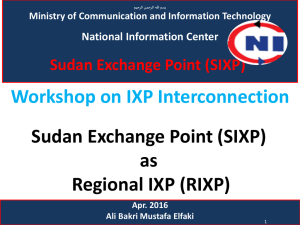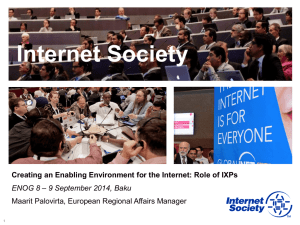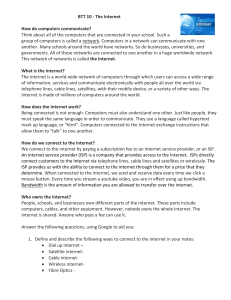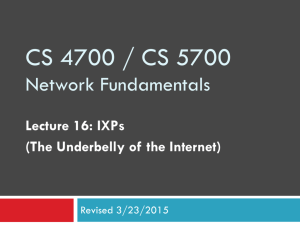Overview of recent changes in the International IP interconnection ecosystem
advertisement
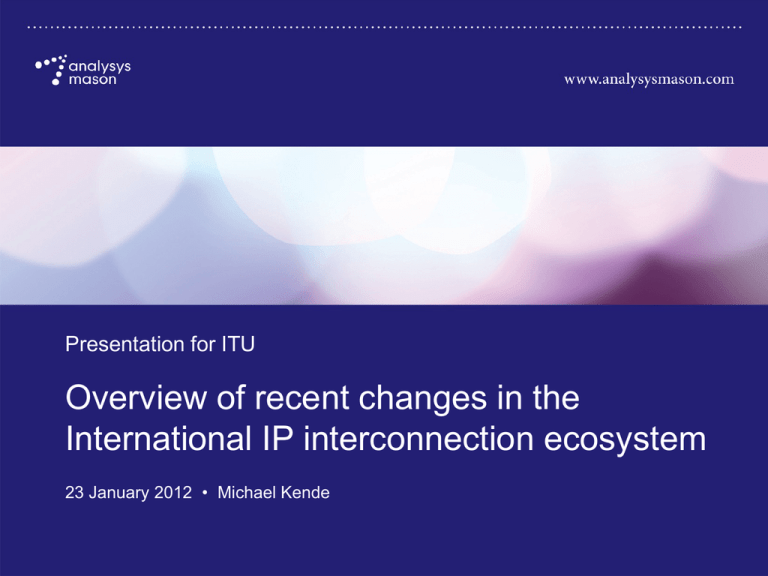
Presentation for ITU Overview of recent changes in the International IP interconnection ecosystem 23 January 2012 • Michael Kende 19236-214 2 Introduction The Internet is characterized by two underlying trends in last fifteen years: The Internet has globalized Internet traffic has increased by many orders of magnitude Interconnection has evolved in response to these trends Internet Exchange Points (IXPs) have helped to localize traffic and increase the efficiency of the Internet Countries with successful IXPs have become regional hubs for traffic We highlight successful case studies and policies that countries can adopt to become a hub, and the impact for countries without those policies 19236-214 3 The commercial Internet is relatively young The National Science Foundation Network (NSFNET) Backbone Service was decommissioned in favor of the commercial Internet on April 15, 1995 The NSFNET was used by regional networks to exchange traffic In its place, four Network Access Points (NAPs) were designated for traffic exchange Interconnection was not regulated – in its place were commercial arrangements (peering and transit) ISP 1 Backbone Network A Backbone Network B Settlementfree transit, paid transit, or peering 19236-214 ISP 2 4 In 1995 the Internet was very US-centric for a number of reasons The US was the historic home of the Internet 70% of Internet users were in the US in 1995, along with much of the content Up to 60% of European traffic routed through the US Much of the European traffic was tromboning through the US back to Europe All European ISPs had to connect to the US to access users and content anyway The lack of liberalization in Europe made national and inter-European links very expensive: in 1998 leased lines prices for a 2 Mbit/s link were: London – Paris: $38,000 / month London – Virginia: $30,000 / month 19236-214 5 The US-centric architecture was not sustainable Evolution of Internet users by region 100% 90% 80% 70% Population split Usage began to change significantly Globalization of users (see right) Content increased in bandwidth Applications became more latency-sensitive, such as VoIP 60% 50% 40% 30% 20% 19236-214 Source: ITU 2009 2008 2007 2006 2005 2004 2003 2002 2001 2000 1999 1998 1997 1996 1995 Tromboning was less sustainable 0% the cost of connectivity fell US & Canada Europe Asia Latin America Africa latency was more notable There were three responses to the US-centric nature of the Internet Interconnection moved from NAPs to IXPs The IXPs began to develop outside the US Some countries sought a policy response to pricing (e.g. ICAIS) 2009 (pop.) 10% 6 The Internet quickly outgrew the Network Access Points Backbone 1 Content provider & aggregator End-user ISP 2 ISP 1 NAP Backbone 3 Backbone 2 ISP 3 ISP 4 Peering Transit Internet Access NAPs were used by large backbones to exchange traffic, reinforcing a hierarchy topped by these backbones Traffic was exchanged via public peering, involving a shared switch that soon congested The owners of the NAPs included operators who were not perceived as neutral in selling access 19236-214 7 Interconnection migrated from Network Access Points to Internet Exchange Points International IXPs address the issues raised Internet backbone by NAPs IXPs are neutral Data Center many are non-profit Content Backbone associations IXP often they are housed within Backbone ISP commercial data centers within the data center, large providers can engage in private peering Domestic network IXPs also flatten the hierarchy of the Internet content providers and ISPs who can use the IXP to peer directly with one another the members of the IXP can also purchase transit services within the data center 19236-214 Content ISP Content ISP 8 There have been three phases of globalization 19236-214 Number of IXPs by region 400 350 Total number of IXPs 300 250 200 150 100 50 North America Europe Asia Latin America Source: Packet Clearing House, Analysys Mason Africa 2010 2009 2008 2007 2006 2005 2004 2003 2002 2001 2000 0 1999 US-Centric phase, for historical reasons starting with the commercialization of the Internet OECD-Centric, focused on developed countries in Europe and Asia Rest of World (ROW) Centric, focused on emerging markets In Africa only two countries had IXPs before 2002, which has risen to 20 by the end of 2010 9 The OECD-Centric phase has drastically reduced Europe’s reliance on the US 100% 90% 80% 70% 60% 50% 40% 30% 20% 10% U.S. & Canada 19236-214 Europe Asia Latin America 2010 2009 2008 2007 2006 2005 2004 2003 2002 2001 0% 2000 Nonetheless, the reliance on the US has now fallen to less than 20% of bandwidth, while Asia is increasingly a destination International Internet bandwidth from European countries, by region 1999 The early IXPs in Europe were setup before 1999, significantly reducing tromboning before this dataset starts Africa Source: Telegeography Global Internet Bandwidth 10 The OECD-Centric phase has also reduced Asia’s reliance on the US 100% 90% 80% 70% 60% 50% 40% 30% 20% 10% U.S. & Canada 19236-214 Europe Asia Latin America 2010 2009 2008 2007 2006 2005 2004 2003 2002 2001 0% 2000 Intra-Asian traffic has increased as more traffic localizes, while Europe is increasingly a destination for traffic exchange International Internet bandwidth from Asian countries, by region 1999 Asia had a later start in localizing traffic, but has now reduced reliance on the US for Internet bandwidth by half Africa Source: Telegeography Global Internet Bandwidth 11 The ROW-phase has not had as great an impact on Latin America Latin American reliance on the US has begun to fall, but is still above 80% Unlike the African situation, intra-regional traffic is growing, but still demonstrates the need for continued localization International Internet bandwidth from Latin American countries, by region 100% 90% 80% 70% 60% 50% 40% 30% 20% 10% U.S. & Canada 19236-214 Europe Asia Latin America 2010 2009 2008 2007 2006 2005 2004 2003 2002 2001 2000 1999 0% Africa Source: Telegeography Global Internet Bandwidth 12 Africa has shifted it’s reliance from the US to Europe 100% 90% 80% 70% 60% 50% 40% 30% 20% 10% U.S. & Canada 19236-214 Europe Asia 2010 2009 2008 2007 2006 2005 2004 2003 2002 2001 0% 2000 However, the reliance has shifted to Europe, which demonstrates both the adaptability of the Internet structure but also the need for continued localization in Africa International Internet bandwidth from African countries, by region 1999 African reliance on the US for Internet bandwidth has reduced drastically Africa Source: Telegeography Global Internet Bandwidth 13 A successful IXP can evolve from acting as a ‘spoke’ to a ‘hub’ IXP evolution No IXP IXP ‘spoke’ IXP ‘hub’ Content provider Content provider ISP 4 ISP 4 ISP 4 IXP IXP IXP International International International Country A Country A ISP 2 ISP 1 ISP 2 ISP 1 Country A ISP 1 Content provider IXP ISP 3 19236-214 An IXP ‘spoke’ can quickly eliminate tromboning, but still accesses content and international transit abroad IXP ISP 3 ISP 2 An IXP ‘hub’ acts as a magnet for content and international backbones to sell services in the country and greater region ISP 3 14 The evolution to IXP ‘hub’ may require broad policy changes, with corresponding benefits 19236-214 International Internet bandwidth per capita 160.0 140.0 120.0 100.0 80.0 60.0 40.0 20.0 Australia USA Canada Germany France Singapore UK Netherlands Source: Telegeography Global Internet Bandwidth 2008 2007 2006 2005 2004 2003 0.0 2002 kbit/s Creation of an IXP ISPs can act together to create an IXP The ability of an IXP to become a hub lies outside of the control of the IXP Two sets of factors impact the evolution of the IXP into a hub general business environment sector policies including international liberalization, and licensing requirements and obligations The impact of AMS-IX is noticeable in terms of bandwidth per capita (see right) 15 The Kenya IXP (KIXP) represents a successful case study An association of ISPs in Kenya (TESPOK) setup KIXP in Nairobi in early 2000 The immediate benefit was to eliminate reliance on satellite for tromboning, reducing latency and cost significantly Telkom Kenya challenged the IXP but was denied The growth in the IXP has been significant There are now 28 members peering at KIXP, including all major operators, a government network, and several DNS servers KIXP is one of the fastest growing IXPs in the world, peaking at up to 1Gbps traffic recently 19236-214 16 KIXP has generated a virtuous cycle of growth Google put a cache in Nairobi available to all members of the IXP, increasing usage (and data revenues) while lowering international bandwidth costs The .ke ccTLD (KENIC) has seen significant growth in domains, at the expense of gTLDs such as .com The tax authority (KRA) sees the exchange as vital to its ability to tax imports and raise income taxes A second IXP has opened in Mombasa to benefit from proximity to the new cables that have landed recently The IXP is increasingly serving regional routes to countries as far away as Nigeria 19236-214 Analysys Mason has been engaged by the Internet Society to conduct a study of the benefits of KIXP – the paper should be released in February 17 The impact of Internet trends only highlights the need for Internet hubs in emerging markets The reliance on Internet access and content is increasing Cloud-based computing Accessed by smart-devices Policy solutions should focus on creating local hubs, rather than simply lowering the cost of acting as a spoke As demand increases, international access costs will continue to rise In addition, access to local or regional IXPs will reduce latency and improve resiliency 19236-214 Summary of Internet trends Source: Analysys Mason 18 Contact details Michael Kende Partner michael.kende@analysysmason.com Analysys Mason Limited Tel: +41 078 698 31 70 www.analysysmason.com Registered in England No. 5177472 19236-214
